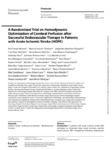A randomized trial on hemodynamic optimization of cerebral perfusion after successful endovascular therapy in patients with acute ischemic stroke (HOPE)

Ver/Abrir
Use este enlace para citar
http://hdl.handle.net/2183/39924
Excepto si se señala otra cosa, la licencia del ítem se describe como Creative Commons Attribution-NonCommercial 4.0 International License (CC-BY-NC 4.0)
Colecciones
- Investigación (FCS) [1293]
Metadatos
Mostrar el registro completo del ítemTítulo
A randomized trial on hemodynamic optimization of cerebral perfusion after successful endovascular therapy in patients with acute ischemic stroke (HOPE)Autor(es)
Fecha
2024-08-29Cita bibliográfica
Camps-Renom P, Guasch-Jiménez M, Martínez-Domeño A, Prats-Sánchez L, Ramos-Pachón A, Álvarez-Cienfuegos J, Silva Y, Fortea-Cabo G, Morales-Caba L, Rodríguez-Campello A, Giralt-Steinhauer E, Flores A, Ustrell X, López-Hernández N, Corona-García DJ, Freijo-Guerrero MM, Luna A, Tejada-Meza H, Marta-Moreno J, Moniche F, Pardo-Galiana B, Castellanos M, Albert-Lacal L, Sanz-Monllor A, Aguilera-Simón A, Marín R, Ezcurra-Díaz G, Lambea-Gil Á, Martí-Fàbregas J. A Randomized Trial on Hemodynamic Optimization of Cerebral Perfusion after Successful Endovascular Therapy in Patients with Acute Ischemic Stroke (HOPE). Cerebrovasc Dis. 2024 Aug 29:1-8.
Resumen
[Abstract] Introduction: In patients with acute ischemic stroke (AIS) secondary to intracranial large vessel occlusion, optimal blood pressure (BP) management following endovascular treatment (EVT) has not yet been established. The randomized trial on Hemodynamic Optimization of Cerebral Perfusion after Successful Endovascular Therapy in Patients with Acute Ischemic Stroke (HOPE) (clinicaltrials.gov id: NCT04892511) aims to demonstrate whether hemodynamic optimization using different systolic BP targets following EVT according to the degree of final recanalization, is more effective than currently recommended BP management in improving functional outcomes of patients with AIS.
Methods: HOPE is an investigator-initiated multicenter clinical trial with randomized allocation, open-label treatment, and blinded endpoint evaluation (PROBE). Patients with an anterior circulation AIS within 24 h of symptom onset, treated with EVT, and showing successful recanalization (mTICI ≥2b) at the end of the procedure, are equally allocated (1:1) to hemodynamic optimization according to the study protocol versus BP management according to current guidelines (≤180/105 mm Hg). The protocol includes two different targets of systolic BP depending on the recanalization status (mTICI = 2b: 140-160 mm Hg; mTICI = 2c/3: 100-140 mm Hg). The protocol is applied within the first 72 h and includes BP lowering as well as vasopressor therapies when needed. The primary outcome is the proportion of favorable outcome (modified Rankin Scale [mRS] 0-2) at 90 days. Secondary outcomes include the shift on the mRS score, neurological deterioration, symptomatic intracerebral hemorrhage, and mortality.
Conclusion: The HOPE trial will provide new information on the safety and efficacy of different BP targets following EVT according to the degree of final recanalization in patients with AIS.
Palabras clave
Blood pressure
Endovascular treatment
Ischemic stroke
Protocol
Endovascular treatment
Ischemic stroke
Protocol
Versión del editor
Derechos
Creative Commons Attribution-NonCommercial 4.0 International License (CC-BY-NC 4.0)
ISSN
1015-9770






